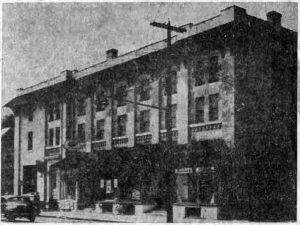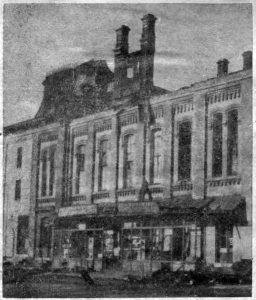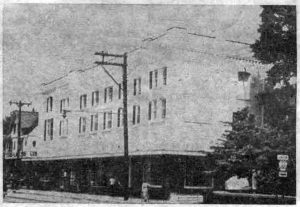“Wayne’s most modern building”, as the Colonial Building has been called in advertisements pertaining to office space therein, is in reality one of Wayne’s oldest edifices. Lyceum Hall, a small, square building erected on the northeast corner of Lancaster avenue and North Wayne avenue in 1871, forms the nucleus of this structure.
J. Henry Askin, one of the founders of Wayne, whose original home was “Louella House”, now the Louella Apartments, donated the ground on which the Lyceum was built.
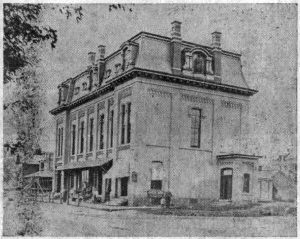
When the building was dedicated on October 24, 1871, Mr. Askin was the first speaker on a program which marked a great occasion in the history of early Wayne. More than 500 men, women and children filled to overflowing the large hall on the second floor. The weekly “Wayne Gazette”, in describing the occasion, stated that “we certainly must not be considered egotistical in saying that the dedication of Wayne Lyceum Hall was most successful. We doubt if an audience larger in members or one so highly intelligent has assembled in any public hall in Delaware or Chester county on any occasion”.
The building was described as “built of brick, rough cast in imitation of granite, three stories high… The first floor contains two large stores each 20 by 40 feet, and an office of the same size. The other room on the same floor, which is the reading and library room of the Lyceum, is 55 by 40 feet. It has a gallery and stage with rooms for the president and secretary… The third floor is being finished as a Masonic Hall and is intended to be used for a new Masonic Lodge”. This was the first home of Wayne Lodge 581, F. and A.M.
In 1889 the Wayne Estate enlarged the store, adding a new proscenium and scene shifts. Then again, in 1903, the building was remodeled and enlarged, provision being made at that time for the housing of the Wayne Post Office. Thereafter it became the center of community activities for Wayne, with the European concerts and other events of social and musical interest being given there. The Opera House, as it was called by this time, rented space to the first motion picture theater in Wayne, which was run by the Messrs. Allen.
In the early morning hours of December 30, 1914, the worst fire that Wayne had experienced since the old Bellevue Hotel burned to the ground in March, 1900, partially destroyed the Opera House. Starting in the office of the Counties Gas and Electric Company on the west side of the building, the fire spread rapidly to the Post Office and to the Welsh and Park Hardware store, as well as to the Auditorium, the Wayne Plumbing and Heating Company office, the Wendell and Treat office, and the quarters of the Wayne Lodge.
The Radnor Fire Company had but two engines at that time. However, reinforcements arrived on the scene so speedily that eight streams of water were soon playing on the fire.
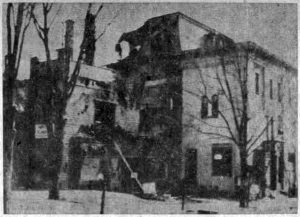
The losses of the tenants in the building mounted into many thousands of dollars, in addition to the losses suffered by the owners of the Opera House. However, within a comparatively short time the extensive repairs were completed and tenants returned to their former quarters. After the completion of these repairs the appearance of the Opera House was very much as it remained up to the time of the extensive alterations made in 1950-51 by Main Line Investments, Inc.
